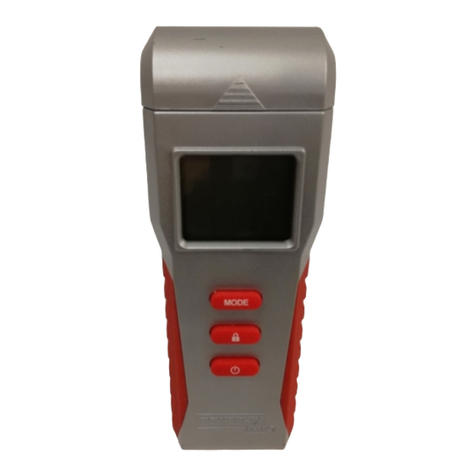19
Of 15 degrees of longitude centered upon a central meridian. This central meridian for a zone is
defined in terms of its position relative to a universal reference, the GMT (Greenwich Prime
Meridian). In otherwords, the centralmedian of eachzone has alongitude divisible by15 degrees.
The number of hours that must be added or subtracted from local civil time in the zone to
Greenwich time dependingon East longitudeand West longitude.
Battery Status Icon
Just below the altitude data field locates the battery status icon. Capacity of batteries in use is
divided into four scales, with icon Signifying full, empty. However it's not necessary for
user to recharge the batteries when batteries status icon is empty. The Polaris incorporates low-
battery shutdown technology in its hardware, at the moment when remaining power can not
sustain the wholesystem, the unitwill automatically turnoff and save all data.
Since Polaris can be power-sourced both from rechargeable type of batteries, such as NiMH/
NiCd and Non-rechargeable type as Alkaline, it's recommended to pay enough notice to the type
of battery. Remember to push the charging switch to lower side when installing non-rechargeable
battery.
To charge, user should make sure rechargeable batteries are in use and charging switch in the
upper side. When batteries is charged to full, Icon. Will keep blinking, system will
automatically reduce charging current to a very low value so that no damages will be caused when
user fail toremove the charging plug fromthe charging port.
Figure 13: charging process Figure14: Thermometer
Thermometer
Figure 14 illustrates the Polaris's thermometer which is divided into two graded bars with
different range of temperature joined at 24 Celsius degree. The left signifies the celsiur scale from
ten below zeroto 24 degreesabove zero whileright signifies from25 to 60degree above zero.
POLARIS USER MANUALPOLARIS USER MANUAL
Navigation pointer,If a specificdestination has beeninput, the arrowof
the pointer willkeep pointing inthe direction leadingto the destination.
When installing batteriesfor the firsttime and failingto input a
destination, navigation pointerremains inactive, astate in whichthe
arrow disappears andthe four axesstay right andstable while centered
data field showsthe user's orientation.
Compass icon-after calibration,the arrow keepspointing to the
geomagnetic north. Wheninstalling batteries forthe first timeand
failing to calibrate,it remains fixedin NW, a character centering in the
ring of navigationpointer.
Thermometer Icon, performingas atmosphere temperatureindicator,
with the leftone showing temperaturefrom -10 to24 degree inCelsius
or 14 to76 degree inFahrenheit, the rightone showing from25 to 60
degree in Celsiusor 77 to140 degree inFahrenheit.
Distance data field,working as anodometer and straightline distance
calculator. Wheninstalling batteries for the time and failing to input a
destination before, itwill not recordthe distance usertravel and remain
showing zero. Onlywhen a certaindestination is inputdoes the
odometer start recordingthe distance thatuser travel, andat
the same timecalculate straight linedistance between startingwaypoint
to destination ,and also straightline distance betweenstarting
waypoint to usercurrent position .
Local time clock,acting as thetype in commonuse, hour,minute and
second of whichcan be setor calibrated accordingto GMT. When
installing batteries forthe first time,it runs fromzero.
Note: When in useor because of low battery shutdown, removing batteries
from the unitfor a shot time will not cause losses of geographic information,
navigational and timingdata,however force the local time clock to stop running
and therefore causea delay of time slot when reinstalling batteries to the unit.
Greenwich Mean Time, after a successful start (the first position has
been fixed), synchronizethe time retrievedfrom GPS satellite
transmitted data whichis in accordancewith the universaltime
coordinate. If GPSsignal fails toreach the unit(or GPS signalicon
start blinking), itstop running andkeep showing thetime, until having
tracked the GPSsignal again.
Speed data field,functioning as speedometer, displaying the instant
speed of theunit after asuccessful start.If GPSsignal fails toreach the
unit (or GPSsignal icon startblinking), the valueof it willfail to
reflect the realspeed of theunit until havingtracked the GPSsignal
again.
Satellite Icon, aftera successful, thenumber of itindicates how many
satellites are beingtracked. As soonas GPS signalis obstructed from
reaching the unit,all the iconwill disappear fromthe display.
Battery icon, performancesas remaining batterypower indicator with
icon signifying fullpower, emptypower.
Altitude data field,after a successfulstart (the firstposition has been
fixed), always displayuser's current altitude;before that itkeep display
the altitude ofthe last positionfix. When installingbatteries for thefirst
time and beforethe first positionfix, this fieldkeeps showing zero.
6




























